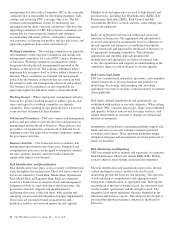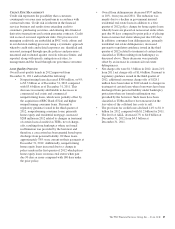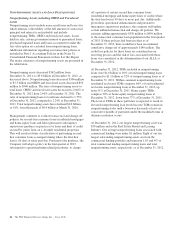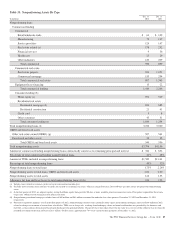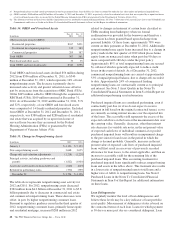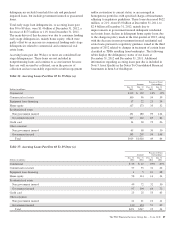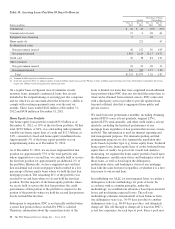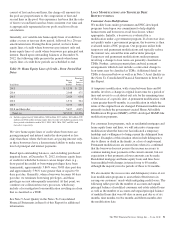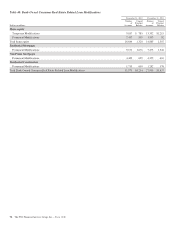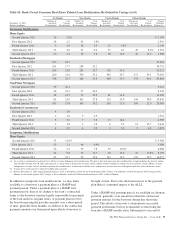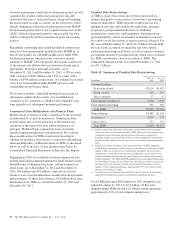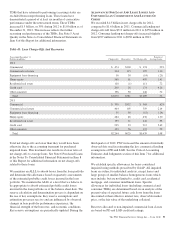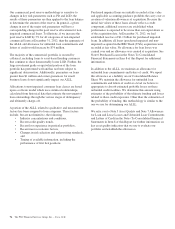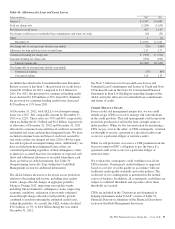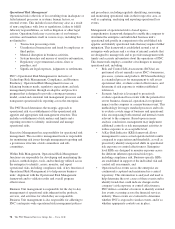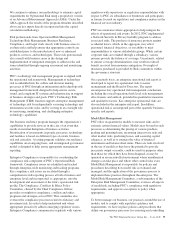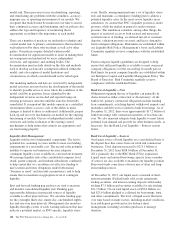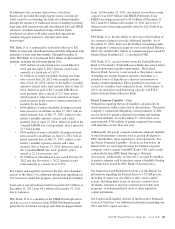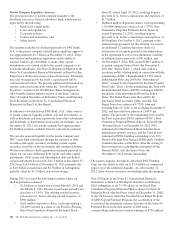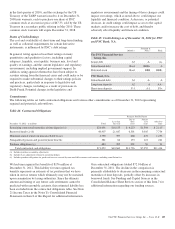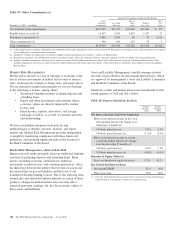PNC Bank 2012 Annual Report Download - page 113
Download and view the complete annual report
Please find page 113 of the 2012 PNC Bank annual report below. You can navigate through the pages in the report by either clicking on the pages listed below, or by using the keyword search tool below to find specific information within the annual report.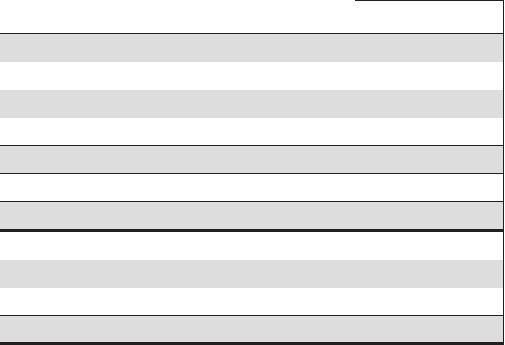
borrower performance under the trial payment period, we will
capitalize the original contractual amount past due and
restructure the loan’s contractual terms, along with bringing
the restructured account to current. As the borrower is often
already delinquent at the time of participation in the HAMP
trial payment period, there is not a significant increase in the
ALLL. If the trial payment period is unsuccessful, the loan
will be evaluated for further action based upon our existing
policies.
Residential conforming and certain residential construction
loans have been permanently modified under HAMP or, if
they do not qualify for a HAMP modification, under PNC-
developed programs, which in some cases may operate
similarly to HAMP. These programs first require a reduction
of the interest rate followed by an extension of term and, if
appropriate, deferral of principal payments. As of
December 31, 2012 and December 31, 2011, 4,188 accounts
with a balance of $627 million and 2,701 accounts with a
balance of $478 million, respectively, of residential real estate
loans have been modified under HAMP and were still
outstanding on our balance sheet.
We do not re-modify a defaulted modified loan except for
subsequent significant life events. A re-modified loan
continues to be classified as a TDR for the remainder of its
term regardless of subsequent payment performance.
Commercial Loan Modifications and Payment Plans
Modifications of terms for large commercial loans are based
on individual facts and circumstances. Commercial loan
modifications may involve reduction of the interest rate,
extension of the term of the loan and/or forgiveness of
principal. Modified large commercial loans are usually
already nonperforming prior to modification. We evaluate
these modifications for TDR classification based upon
whether we granted a concession to a borrower experiencing
financial difficulties. Additional detail on TDRs is discussed
below as well as in Note 5 Asset Quality in the Notes To
Consolidated Financial Statements in Item 8 of this Report.
Beginning in 2010, we established certain commercial loan
modification and payment programs for small business loans,
Small Business Administration loans, and investment real
estate loans. As of December 31, 2012 and December 31,
2011, $68 million and $81 million, respectively, in loan
balances were covered under these modification and payment
plan programs. Of these loan balances, $24 million have been
determined to be TDRs as of both December 31, 2012 and
December 31, 2011.
Troubled Debt Restructurings
A TDR is a loan whose terms have been restructured in a
manner that grants a concession to a borrower experiencing
financial difficulties. TDRs typically result from our loss
mitigation activities and include rate reductions, principal
forgiveness, postponement/reduction of scheduled
amortization, extensions, and bankruptcy discharges from
personal liability, which are intended to minimize economic
loss and to avoid foreclosure or repossession of collateral. For
the year ended December 31, 2012, $3.1 billion of loans held
for sale, loans accounted for under the fair value option,
pooled purchased impaired loans, as well as certain consumer
government insured or guaranteed loans which were evaluated
for TDR consideration, are not classified as TDRs. The
comparable amount for the year ended December 31, 2011
was $2.7 billion.
Table 42: Summary of Troubled Debt Restructurings
In millions
Dec. 31
2012
Dec. 31
2011
Consumer lending:
Real estate-related $2,028 $1,492
Credit card (a) 233 291
Other consumer 57 15
Total consumer lending (b) 2,318 1,798
Total commercial lending 541 405
Total TDRs $2,859 $2,203
Nonperforming $1,589 $1,141
Accruing (c) 1,037 771
Credit card (a) 233 291
Total TDRs $2,859 $2,203
(a) Includes credit cards and certain small business and consumer credit agreements
whose terms have been restructured and are TDRs. However, since our policy is to
exempt these loans from being placed on nonaccrual status as permitted by
regulatory guidance as generally these loans are directly charged off in the period
that they become 180 days past due, these loans are excluded from nonperforming
loans.
(b) Pursuant to regulatory guidance issued in the third quarter of 2012, additional
troubled debt restructurings related to changes in treatment of certain loans of $366
million in 2012, net of charge-offs, resulting from bankruptcy where no formal
reaffirmation was provided by the borrower and therefore a concession has been
granted based upon discharge from personal liability were added to the consumer
lending population. The additional TDR population increased nonperforming loans
by $288 million. Charge-offs have been taken where the fair value less costs to sell
the collateral was less than the recorded investment of the loan and were $128.1
million. Of these nonperforming loans, approximately 78% were current on their
payments at December 31, 2012.
(c) Accruing loans have demonstrated a period of at least six months of performance
under the restructured terms and are excluded from nonperforming loans.
Total TDRs increased $656 million or 30% during the year
ended December 31, 2012 to $2.9 billion. Of this total,
nonperforming TDRs totaled $1.6 billion, which represents
approximately 49% of total nonperforming loans.
94 The PNC Financial Services Group, Inc. – Form 10-K


